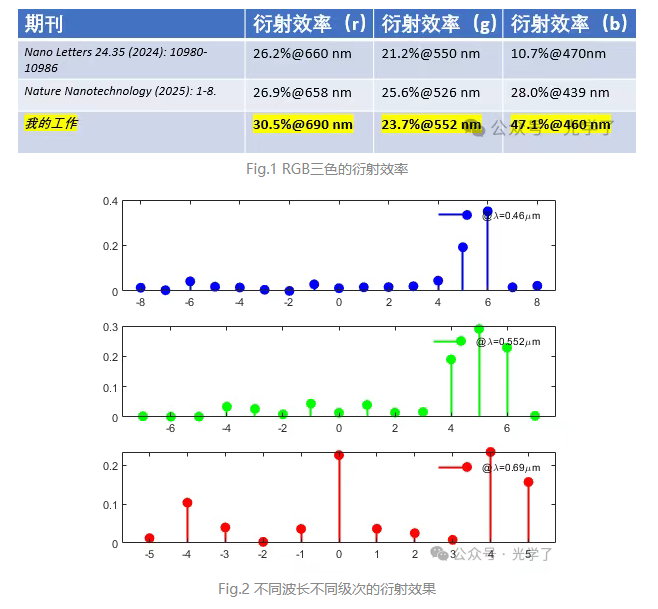23
2025
-
06
Achromatic diffractive waveguide in AR glasses
Author:
AR glasses seem to have developed rapidly in recent years; many believe this is the device most likely to replace smartphones in the future. Many consumer market manufacturers in China, such as Thunder Bird Innovation, XREAL (Younai Koen (Beijing) Technology Co., Ltd.), Rokid (Hangzhou Lingban Technology Co., Ltd.), and INMO (Sichuan Yingmu Technology Co., Ltd.), are also involved.
A core component in AR glasses is the waveguide, which plays a key role in augmented reality devices. Waveguides utilize the principle of total internal reflection to transmit information, providing users with an immersive visual experience.
Key indicators for waveguides include:
-
Field of View (FOV) : Determines the range of virtual images the user can see; a larger FOV provides a wider field of vision. -
Eye Box : Refers to the range of movement for the user's eyes; a larger eye box improves wearing comfort. -
Diffraction Efficiency : Affects image brightness and clarity; a highly efficient diffraction waveguide reduces light loss and improves display quality.
These indicators together determine the performance of the diffraction waveguide, which in turn affects the overall AR glasses experience.
The most mainstream waveguide implementations are geometric waveguides and diffraction waveguides . Geometric waveguides have good optical performance with essentially no noticeable chromatic aberration. However, the manufacturing yield is very low, posing significant mass production challenges ( To achieve pupil expansion, geometric waveguides require many layers of film with different reflection/transmission efficiencies within the waveguide; the film system is very complex ).
Currently, diffraction waveguides are a viable implementation approach. Their manufacturing process is less complex than that of geometric waveguides, but they exhibit noticeable chromatic aberration. This is because the inherent dispersion of diffraction makes it difficult to achieve ideal achromatic results. Much current work is using SiC material; its high refractive index provides greater design space and allows for stronger chromatic dispersion compensation. Simultaneously, there is much research on non-local structures, which may overcome the technical bottlenecks of insufficient chromatic dispersion compensation and mode impedance mismatch caused by the limited resonance bandwidth and scattering ability of traditional local structures.
Currently, much research focuses on achieving achromatic information image transmission with high integration and thin, lightweight single-layer diffraction waveguides. Several similar studies have been published recently. The author has also attempted to design similar structures, with the following diffraction efficiency:

I've always had a question about diffraction efficiency, It's said that the efficiency of diffraction waveguides is low. Is it really that low? Or is it because pupil expansion necessitates low single-emission efficiency? In addition, the uniformity of diffraction efficiency is also very demanding in practical applications; otherwise, the rainbow effect will be very obvious. Should the priority of uniformity in three-color efficiency be higher than diffraction efficiency in design? ?
I wonder if any friends from the industry or those very familiar with engineering design have seen this post and would like to discuss it.
Is there much significance in simply designing a diffraction waveguide with ultra-high efficiency and achromatic single layer? I have been considering designing diffraction waveguides by setting refractive index discontinuities in the periodic structure and optimizing the position of the refractive index discontinuities to find suitable structures. However, I don't know what the appropriate objective optimization function is (mainly because I don't understand the priority of performance indicators for diffraction waveguides in practical applications).
LATEST NEWS
2025-07-12
Hyperspectral channel density on-chip diffractive speckle spectrometer
Driven by the demand for high-performance miniature spectrometers, research on chip-scale spectrometers is continuously breaking through towards high integration, high resolution, and large bandwidth. This work proposes a silicon-based on-chip spectrometer based on cascaded disordered metasurfaces. Through various on-chip wavefront modulation mechanisms, high-spectral speckle is generated, which expands the number of spectral channels with a compact chip size, thus achieving extremely high on-chip spectral channel density and providing an effective means for achieving high-resolution, large-bandwidth spectral detection.
2025-07-14
Ultrasensitive room-temperature extreme photoelectric response achieved
This study, for the first time, achieved the control of ultra-sensitive photoelectric response optimized for room temperature conditions through electromagnetically induced potential well effects and exciton insulator phase transition characteristics.
2025-07-15
Preparation and research progress of glass scintillators for X-ray imaging
Developing suitable host materials with strong X-ray absorption coefficient, good exciton transport efficiency, low phonon energy, and high lanthanide ion solubility remains a cutting-edge research direction in the field of X-ray detection.
2025-07-16
Quantum logic gates based on single-piece gradient metasurface
In today's rapidly developing quantum information technology, realizing efficient and highly integrated quantum logic gates is one of the key challenges in the field of integrated quantum optics.
2025-07-17
Preparation and performance study of epoxy-thiol high-contrast color polymer dispersed liquid crystals
Polymer Dispersed Liquid Crystal (PDLC) is a smart material consisting of micron-sized liquid crystal droplets dispersed in a polymer matrix.

